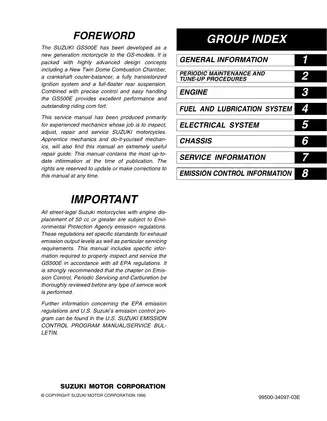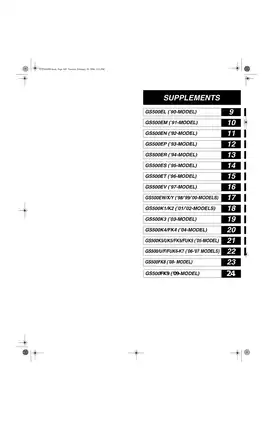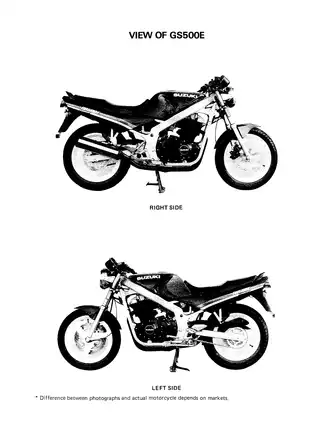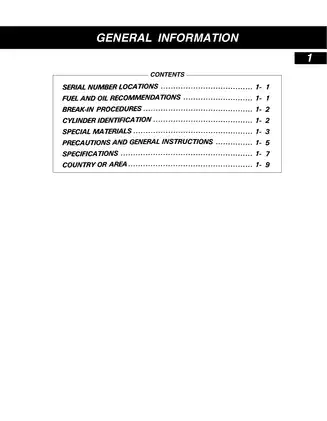Suzuki GS500EL, GS500EM, GS500EN, GS500EP, GS500ER Motorcycle Service Manual Comprehensive Repair & Maintenance 1990-2009
Product Gallery

Sample pages from the Suzuki GS500EL, GS500EM, GS500EN, GS500EP, GS500ER Motorcycle Service Manual Comprehensive Repair & Maintenance 1990-2009 manual




Purchase Information
1989-2009 Suzuki GS500E Motorcycle Service Manual - Technical Specifications
- Document Number / Seller:
- 24603 / Michael Bell
- File Size:
- 15.03 MB
- File Type:
- Language:
- English (some of our manuals are multi-language)
- Printable:
- Yes
- Estimated Download Time:
- 0.31 Minutes
- Delivery Format:
- Digital (PDF) - Instant Access
- Category:
- Motorcycle
- Brand:
- Suzuki
Suzuki Models and Parts Covered in this Motorcycle Manual
- GS500EL (1990)
- GS500EM (1991)
- GS500EN (1992)
- GS500EP (1993)
- GS500ER (1994)
- GS500ES (1995)
- GS500ET (1996)
- GS500EV (1997)
- GS500EW (1998)
- GS500EX (1999)
- GS500K1 (2001)
- GS500K2 (2002)
- GS500K3 (2003)
- GS500K4 (2004)
- GS500K5 (2005)
- GS500K6 (2006)
- GS500K7 (2007)
- GS500FK8 (2008)
- GS500FK9 (2009)
Complete Manual Information
Suzuki GS500E Motorcycle Service Manual (1990-2009)
The Suzuki GS500E Motorcycle Service Manual is an essential guide for both professional mechanics and do-it-yourself enthusiasts. This comprehensive manual covers everything from routine maintenance to detailed troubleshooting. It is specifically designed for the GS500E, a popular motorcycle known for its performance and reliability.
What’s Inside
- General Information: Serial number locations, fuel and oil recommendations, break-in procedures, and special materials required for servicing.
- Periodic Maintenance Procedures: Maintenance schedules, lubrication points, and clear instructions on battery care and servicing the carburetor and clutch.
- Engine: Detailed maintenance procedures for the engine including compression pressure checks, oil pressure checks, and rebuilding instructions.
- Electrical System: Comprehensive information on the ignition system, including wiring diagrams, inspection procedures for all electrical components, and troubleshooting tips.
- Chassis: Step-by-step instructions on servicing the wheel, rear suspension, brakes, and steering.
- Troubleshooting Guide: Common problems, symptoms, possible causes, and remedies including extensive checks of the engine, brakes, and electrical systems.
- Special Tools: A detailed list of all tools necessary for service and repair operations, along with descriptions of each tool's purpose.
This service manual contains crucial information on maintaining the safety and performance of your Suzuki GS500E. Whether you are conducting simple maintenance or extensive repairs, this manual will help you get the job done right, ensuring your motorcycle runs smoothly for years to come
Download Instructions for Suzuki Motorcycle Manual
Frequently Asked Questions - Suzuki Motorcycle Manual
What does this Suzuki manual cover?
This comprehensive service manual covers detailed repair procedures, maintenance schedules, troubleshooting guides, and technical specifications for Suzuki GS500EL, GS500EM, GS500EN, GS500EP, GS500ER Motorcycle Service Manual Comprehensive Repair & Maintenance 1990-2009. It includes information for the following models: - GS500EL (1990) - GS500EM (1991) - GS500EN (1992) - GS500EP (1993) - GS500ER (1994) - GS500ES (1995) - GS500ET (1996) - GS500EV (1997) - GS500EW (1998) - GS500EX (1999) - GS500K1 (2001) - GS500K2 (2002) - GS500K3 (2003) - GS500K4 (2004) - GS500K5 (2005) - GS500K6 (2006) - GS500K7 (2007) - GS500FK8 (2008) - GS500FK9 (2009).
Is this manual suitable for beginners?
Yes, this Suzuki manual is designed for both professional technicians and DIY enthusiasts. It includes step-by-step procedures with clear illustrations and safety guidelines for Motorcycle maintenance and repair.
What file format will I receive?
You will receive this manual as a PDF file (15.03 MB), which is compatible with all devices. The manual is fully searchable and printable for your convenience.
How quickly can I access the manual after purchase?
You'll receive instant access to your Suzuki Motorcycle manual immediately after payment completion. The download link is valid for 3 days, with lifetime re-download guarantee.
Are engine specifications included?
This motorcycle service manual includes detailed engine specifications, valve clearances, torque settings, and performance data specific to your Suzuki model.
Can I print specific sections of the manual?
Absolutely! This digital manual allows you to print any section you need, from individual pages to complete chapters, making it perfect for workshop use.
Customer Reviews and Feedback
Read what our customers say about this Suzuki Motorcycle manual and share your own experience.
Add Comment
This policy contains information about your privacy. By posting, you are declaring that you understand this policy:
- Your name, rating, website address, town, country, state and comment will be publicly displayed if entered.
- Aside from the data entered into these form fields, other stored data about your comment will include:
- Your IP address (not displayed)
- The time/date of your submission (displayed)
- Your email address will not be shared. It is collected for only two reasons:
- Administrative purposes, should a need to contact you arise.
- To inform you of new comments, should you subscribe to receive notifications.
- A cookie may be set on your computer. This is used to remember your inputs. It will expire by itself.
This policy is subject to change at any time and without notice.
These terms and conditions contain rules about posting comments. By submitting a comment, you are declaring that you agree with these rules:
- Although the administrator will attempt to moderate comments, it is impossible for every comment to have been moderated at any given time.
- You acknowledge that all comments express the views and opinions of the original author and not those of the administrator.
- You agree not to post any material which is knowingly false, obscene, hateful, threatening, harassing or invasive of a person's privacy.
- The administrator has the right to edit, move or remove any comment for any reason and without notice.
Failure to comply with these rules may result in being banned from submitting further comments.
These terms and conditions are subject to change at any time and without notice.
Comments (5)